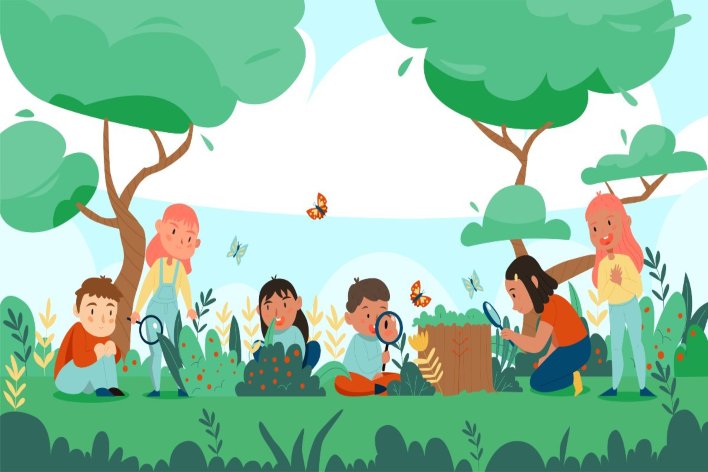The Benefits of Outdoor Learning: Nature as a Classroom

Imagine a classroom with no walls, fresh air, and sunshine, with the sound of birds chirping. What does that look like? That is what it feels like when outdoor learning is done. Instead of being inside all day, students get to go out into the environment and learn from nature. This has become more common in schools as it helps kids to learn enjoyably and actively. In this blog, we consider what the concept of outdoor learning is, the benefits of outdoor learning in preschools and primary schools, and how schools utilize nature in their classroom.
What is Outdoor Learning?

Outdoor learning occurs when lessons and activities are taken out into nature or other outdoor settings outside a traditional indoor classroom. For instance, instead of instruction involving books and desks, learning outdoors uses trees, plants, water, and open spaces to show critical life lessons. It could be at school gardens, parks, or even on nature walks. Outdoor learning is all about the investigation of the world that is happening around you and how to learn from that. Several subjects could be learned outdoors: science, mathematics, art, and even reading.
Schools that encourage outdoor learning enable students to connect with nature even as they learn the same material a student would indoors. It does not just mean running and playing outside. This will be using nature itself in teaching ways of developing important skills and ideas.
Advantages of Outdoor Learning
The most important advantage of outdoor learning is that it enables students to have fun while learning. When students go outdoors for their learning, they become excited about the discovery of new things. Being outdoors is an invitation to curiosity and exploration.
Increases Interest in Learning
Rather than reading from books what kinds of plants exist, students have the opportunity to observe closely, touch, and even smell different species of plants. All this makes learning quite interesting and one which will be etched in memory for years.
Improves Physical Health
Outdoor learning often incorporates movement. Whether it's walking, running, or performing some other activity, being outdoors entices physical activity. This keeps students active and healthy. The act of moving around helps students let out steam, enabling them to sit and listen later when they need to.
Builds Social Skills
Most often, the outdoor learning activities are participated in through teamwork. Students learn how to share and work with their peers on nature projects or any other outdoor games. These social skills will help them both in and outside the classroom. Outdoor learning also encourages problem-solving as students often have to work together to complete tasks.
Decreases Stress
Being in the natural environment is serene. Fresh air and a natural setting tend to minimize stress and anxiety. Outdoor learning lets students feel more relaxed, which can make learning easier and more enjoyable. When students are less stressed, they become more open to learning new things.
Nurtures Creativity
The outdoors is replete with creativity-inspiring things from the flowers that blossom in color to the unusual rock formations. Nature has several ways of spurring creative thinking in students. Outdoor learning encourages students to use their imagination. For example, a nature walk can become a creative writing session wherein one describes what one sees, hears, and feels.
Nurtures Environmental Awareness
Outdoor learning promotes student awareness of environmental care and its importance. The longer the period students spend outdoors, the better they become at learning factors related to nature and the environment; these include causes for and against environmental protection. This may probably influence the making of positive environmental choices, such as the facilitation of recycling and water conservation.
Benefits of Outdoor Learning in Preschool
In preschool, outdoor learning is far more beneficial to younger children. The following are some aspects it enhances:
Enhances Physical Development
Preschoolers like to run, jump, and play. Outdoor learning allows them to utilize large muscles and develop their physical ability. Climbing, running, and balancing develop strength and coordination.
Encourages Sensory Exploration
The various benefits will include allowing young children an opportunity to engage all of their senses in preschool outdoor learning. A child can smell flowers, feel the texture of leaves, and listen to the sounds of animals. These exposures would engage them in sensory activities that would help them learn about the world more enjoyably and interactively.
Attention Span Improvement
Outdoor learning also helps preschoolers focus. Nature is one place where your children get to explore at their own pace, hence improving attention spans. Perhaps the serenity of nature has a rippled effect on them, making it easier for them to concentrate, even indoors.
Nurtures Independence
Outdoor learning activities facilitate children to make their own decisions and be empowered, such as taking which route during a nature walk or building what with sticks. Such activities develop the child to be independent and build confidence in everything they do. This is very important in further enhancing their level of independence and building one's confidence in their abilities. This will not only allow them to control their lives but also to effectively cope with, and adapt to, the demands of living in society.
Benefits of Outdoor Learning in Primary Schools
As children grow up and enter primary school, the advantages of outdoor learning remain constant. Well, this is how continuing outdoor learning will help primary school students:
Supports academic learning
Outdoor learning in primary schools can be utilized in teaching subjects such as science, math, and geography. For instance, the knowledge of the students about plant life can be taught by studying flowers in a garden. Math concepts such as measuring the height of trees make learning better because the lessons become relatable.
Clears the Mind and Improves Focus
As in preschool, outdoor learning in primary school helps students to focus much better. Fresh air together with physical activity may improve concentration, especially among students who find it difficult to sit for long periods. For instance, when the students come back to class after outdoor learning, they are often more focused and prepared for learning.
Develops Problem-Solving Skills
Most times, there is the development of problem-solving skills in outdoor learning activities. Such may be like how a shelter is built with materials in nature. Such activities challenge students to think critically and come up with solutions to these problems for the improvement of their problem-solving skills.
Promotes Responsibility
Most of the primary schools engage in nature care activities as part of outdoor learning. For example, children in school may plant flowers and later ensure that the plants are watered and well taken care of. Such kinds of responsibilities impart into them the spirit of responsibility and care towards living organisms.
Outdoor Learning Programs in Schools
So many schools are starting outdoor learning programs. Other activities in these programs include nature walks, which involve getting children outside to appreciate the beauty of nature, and outdoor science experiments. Schools have outdoor classrooms and gardens where the students learn about the plants, animals, and ecosystems of the world. School outdoor learning programs are going to help connect the learning to the real world.
In some schools, this means teachers take the students outside for regular lessons in such subjects as math and reading. For example, students may count objects found in nature, or write a story about something they see. Outdoor classes make learning fun and much more interactive.
Benefits of Outdoor Learning for Teachers
Outdoor learning isn't just beneficial for the students; teachers benefit as well. In conducting lessons outdoors, teachers can also be more relaxed and innovative in their teaching methods. Teachers can use the surroundings to their advantage by making lessons more interactive and activity-based. As a bonus, it gives them a new perspective on viewing students as they interact with nature and their peers.
Benefits of Outdoor Learning for Schools
It also provides various other advantages to the schools. Outdoor learning allows for the development of a healthy and positive learning environment within a school. Outdoor learning offers an opportunity to shape better student behavior, attendance, and academic performance in most cases. "Students love coming to school knowing that they'll be outside learning". Also, it develops a sense of community because students, teachers, and even parents can be involved with outdoor activities.
Conclusion
Outdoor learning has many advantages for students in preschool, as well as in primary school. It contributes to the improvement of students' physical health, boosts the level of their creativity, and favors academic learning. The final positive outcomes of outdoor learning are that it makes learning fun, helps them focus on their attentiveness, and encourages those important life skills. Schools that utilize full outdoor learning provide their students with an opportunity to explore, discover, and learn naturally and with enthusiasm.
So, the next time you step out, remember that nature can be one of the finest schools!
FAQs
How effective is outdoor learning?
Outdoor education and play support emotional, behavioral, and intellectual development. Studies have shown that students who learn outdoors develop: a sense of self, independence, confidence, creativity, decision-making and problem-solving skills, empathy towards others, motor skills, self-discipline, and initiative.
Why is the outdoor learning environment important?
Children who are taught in an outdoor setting – like an outdoor classroom – score higher on standardized test scores than children taught in a traditional classroom. Why? These students are developing the problem-solving and critical thinking skills often overlooked in traditional classrooms.
What is the purpose of learning outside the classroom?
Learning outside the classroom can help teachers create enthusiasm for learning, provide a real-world context, and expose students to a range of STEM careers. Students who experience learning outside the classroom benefit from increased self-esteem and become more engaged in their education.
Learn about the benefits of outdoor learning in this blog! Share with friends and teachers to inspire outdoor adventures in education!
Other Related Sections
NCERT Solutions | Sample Papers | CBSE SYLLABUS| Calculators | Converters | Stories For Kids | Poems for kids | Practice Worksheets | Formulas IBlogs
Admissions Open for 2025-26
CBSE Schools In Popular Cities
CBSE Schools in Bangalore
CBSE Schools in Mumbai
CBSE Schools in Pune
CBSE Schools in Hyderabad
CBSE Schools in Chennai
CBSE Schools in Gurgaon
CBSE Schools in Kolkata
CBSE Schools in Indore
CBSE Schools in Sonipat
CBSE Schools in Delhi
CBSE Schools in Rohtak
CBSE Schools in Bhopal
CBSE Schools in Aurangabad
CBSE Schools in Jabalpur
CBSE Schools in Jaipur
CBSE Schools in Jodhpur
CBSE Schools in Nagpur
CBSE Schools in Ahmednagar
CBSE School In Tumkur

